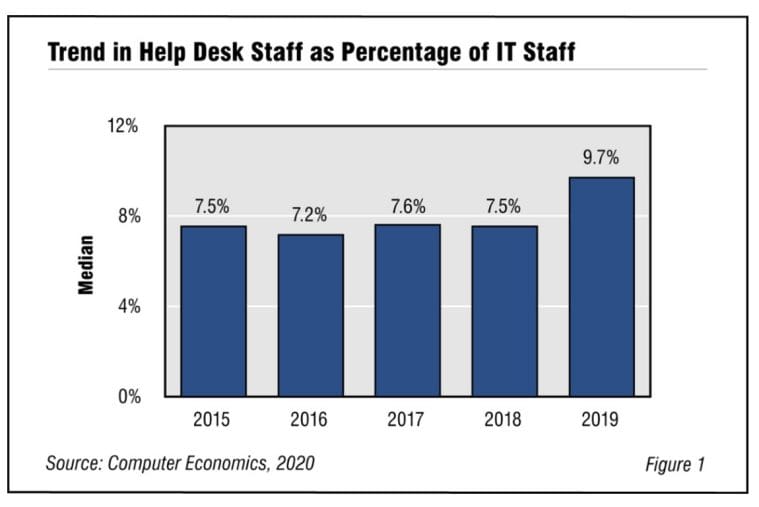Help desk staffing is in a state of flux right now, and right now increasing demands from the business are driving up headcount. In fact, the help desk staffing ratio took a big jump in 2019, bringing it to its highest level in the past five years. As shown in Figure 1 from our full report, Help Desk Staffing Ratios, the ranks of help desk personnel expanded during the past year—reaching 9.7% of the total IT headcount at the median, up from 7.5% in 2018 and 7.6% in 2017.
It is an interesting time for help desk technicians. Some help desk roles are being expanded and elevated. Companies are using a greater variety of business applications, which puts increasing demands on the help desk. And, as we have been reporting, the more companies automate routine business processes, the more people skills matter, and the more experience matters. As a result, the help desk becomes the front line for the IT organization in showing its worth to the user community.

Moreover, for those organizations adopting an IT service management strategy, the help desk takes on an expanded role as the “service desk.” The service desk not only logs and resolves routine incidents, but also becomes the front end for all change requests. The service desk takes on added responsibilities for ensuring that users remain satisfied and productive.
The help desk also plays an important role in the development of IT personnel. It is often the first job for junior hires, and many opportunities exist for entry-level help desk workers to gain experience and move on to higher-paying jobs within the organization.
At the other end of the spectrum, there are factors that may reduce the demand for help desk staff in the future. For instance, help desk technicians are increasingly handling PC issues remotely, reducing the need for on-site staff at every office location. Software as a service (SaaS) applications and desktop virtualization mean that there are fewer business applications running on the user’s local desktop or laptop. (On the other hand, SaaS applications can also create issues for the help desk. See the full report for more on that subject.)
“There’s a bit of a tug-of-war going on with help desk staffing, with user demands pulling up headcount and automation tools pulling it down,” said Tom Dunlap, director of research for Computer Economics, based in Irvine, Calif. “Right now, user demands are winning, so benchmarking against current industry standards is always a good idea.”
The full report provides metrics for benchmarking help desk staffing levels in the current environment. We look at the trend in help desk staffing over a five-year period and provide four benchmarks by organization size and sector: help desk staff as a percentage of the IT staff, users per help desk staff member, applications per help desk staff member, and first-call resolution rates. Because companies organize the end-user support function in different ways, we also provide benchmarks for a combined help desk and desktop support staff. We conclude with recommendations on optimizing help desk staffing levels.
This Research Byte is a brief overview of our report on this subject, Help Desk Staffing Ratios. The full report is available at no charge for Avasant Research subscribers, or it may be purchased by non-subscribers directly from our website (click for pricing).

